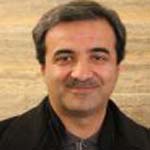Evaluation of quantitative geomorphic indices and cluster analysis in the active tectonic study (Case study: Talvar sub basins)
Investigation morphological of rivers is essential for understanding current conditions and the potential of possible changes of the river in future. Measurement of the geomorphic indicators is one of the methods that can provide the extremely helpful for understanding these changes. In the basin of Talvar the existence of the beds changes has created the issue of research.
The area of the river basin Talvar in Kurdistan province, with a total area of 7,241 square kilometers, is geographically located between 48˚ 06 ́53 ̋ to 48˚ 12 ́ 48 ̋ East and 34˚ 54 ́ 20 ̋ to 36˚ 00 ́ 10 ̋ North. This basin is one of the sub-basins of Ghezel Ozan drainage basin, located at the southern end of the basin, east of Sanandaj. The Talvar drainage basin is one of the sub- basin of drainage basin of GizilOzan that is located at southern part of this pool and north east of Sanandaj. In this study, due to the wide extent of the basin, and also to get more accurate results, the basin of Talvar was divided into 15 sub-basins.
In this study some of important indexes are calculated which included: Sinuosity index (S), Shape basin index (Bs), Asymmetry factor of a drainage basin (AF), Drainage density index (P), Branching ratio index (BR), Time of concentration (Tc), confluence angles.
For the calculation of the time of concentration was used the Kirpich equation. For measurement of the confluence angles was used the Digimizer Software. At the end, data was implemented model of Cluster Analysis in the SPSS software.
Check the value of the S: In the active tectonic areas river is in the form of direct line. If S is low and Closer to the number 1, is represents the tectonic activity in the area. In the study area all of the sub-basins are equal to 1 or close to 1. So all are rated tectonic activity. The amount of S of sub basin number 12 is most of the others. Check the value of the Bs: The Bs value that is larger than the number 2 is indicating longitudinal basin. Lower amounts of it is indicating weak tectonic activities. So in the 1, 2,5,8,9,10,14,15 sub-basins, tectonic activity are high. 4 and 5 sub-basins are medium. 3, 7,11,12,13 sub-basins are weak. Check the value of the AF: The AF indicator is one right way for determine tectonic tilting overload on the scale of the drainage basin. In a sustainable environment, AF should be about 50 that show the perfectly symmetrical drainage basin. So none of the sub-basins are not symmetrical. Check the value of the BR: BR in normal drainage basins is 3-5. So except for the sub- basin No. 1, all other sub-basins are normal. Check the value of the P: High density factor show active tectonic and the high sensitivity of the geological. The lowest value of the density related to sub-basin number 5. Check the value of the Tc: Usually the amount of Tc in a circular basin is shorter. But the stretches basin Tc is more. Maximum value is related to the 1 and 5 basins. Minimum value is related to the number 3. Check the value of the confluence angles: According to the calculations, 2 and 4 sub-basins has the highest average amount of angle and 5 sub-basin has the lowest.
Dendrogram corresponding to s shows that 12 and 13 sub-basins are single groups in terms of high s. and other basin are in a cluster. According to the dendrogram corresponding to BS 1, 8, 14, 15 sub-basins are in a cluster. 3, 12, 13 are in a cluster. 2 and 9 are in a cluster. And 4, 6, 7, 10, 11 are in a cluster. Dendrogram corresponding to AF shows that 1, 6, 14 sub-basins are in a cluster. 5 and 8 are in a cluster. 7 and 10 are in a cluster. 4 and 11 are single groups. And other sub-basins are also fitted up a single cluster. According to the dendrogram, 1 sub-basin is a single group Due to the high coefficient of divergence ratio. 14 and 5 that are longitudinal sub-basins, are in a cluster. 2, 7, 15 are in a cluster and other sub-basins are in a cluster. The density dendrogram shows that 6 and 7 sub-basins that have a high permeability and multiple faults, are in a cluster. 5 and 12 are single groups in terms of relative poverty the density. 1, 4, 10, 13, 14 are in a cluster and other sub-basins are in a cluster. According to the dendrogram 1, 5, 15 sub-basins that are longitudinal sub-basins, are in a cluster. 2,3,10 are in a cluster. Number 7 is a single group. And other sub-basins are in a cluster. The average of confluence angles dendrogram shows that sub-basin 5 is a single group. 6 and 7 are in a cluster. 11,13,14,15 are in a cluster. 1, 3,8,9,10,12 are in a cluster. 2 and 4 are in a cluster. Accordingly, faults caused an increase collision angles. All indicators shows active or relatively tectonic in most sub-basins.
-
flood flow zoning for different return periods using hydrodynamic model HEC-RAS (Case Study: Gomanab Chai River)
Mohammadhossein Rezaei Moghaddam *, Dawood Mokhtari, Tohid Rahimpoor, Meisam Skandar
quantitative geomorphological researches, Spring 2025 -
Flooding Assessment of Qaleh Chai basin Using MABAC Multi Criteria Decision Making Method
Mohammadhossein Rezaei Moghaddam *, Masoumeh Rajabi, Tohid Rahimpour, Ayuob Farazian
Journal of Environmental Hazard Management, Winter 2025 -
Identification of Areas Susceptible to Landslides in the Sarpol Zahab Basin
Asad&#, Ollah Hejazi Hejazi *, Zahra Zanganeh Tabar,
Hydrogeomorphology,


